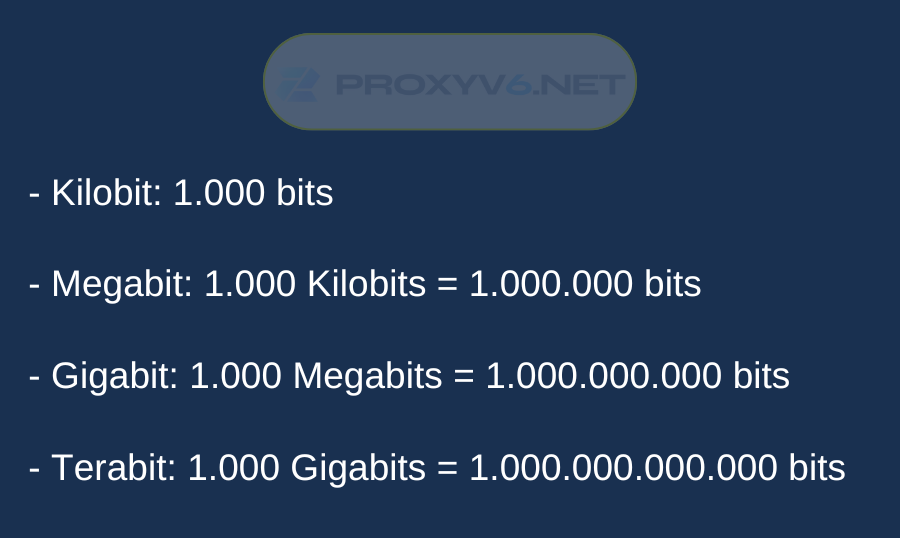This is an extremely important concept in the field of information technology, especially when it comes to network speed and performance. In this article, we will delve into the details of bandwidth and the latest updates for 2024 to understand the significance of bandwidth in improving the online experience. Let’s explore bandwidth with ProxyV6.net to enhance your network performance right away!

What is Bandwidth?
Bandwidth is a familiar term in the field of computer networks, used to describe the data transmission capacity of a communication channel or network. It indicates the amount of data that can be transmitted through the internet within a given time frame.
Bandwidth plays a crucial role in determining internet connection speed and user experience. Understanding bandwidth helps you optimize your network connection, ensuring a smooth and efficient internet experience.
Latest Bandwidth Concepts for 2024
Let’s explore the concepts with ProxyV6.net to understand more about the measurement units and the concepts of Increasing, Decreasing, and Throttling Bandwidth for your system.
What is the Unit of Network Bandwidth?
Bandwidth is measured in bits per second, abbreviated as bps. With technological advancements, today’s bandwidth is often measured in larger units such as Megabits per second (Mbps), Gigabits per second (Gbps), or Terabits per second (Tbps).
Here are some common bandwidth unit conversions:
– Kilobit: 1,000 bits
– Megabit: 1,000 Kilobits = 1,000,000 bits
– Gigabit: 1,000 Megabits = 1,000,000,000 bits
– Terabit: 1,000 Gigabits = 1,000,000,000,000 bits
Additionally, after the Terabit unit, there are larger units such as Petabit, Exabit, Zettabit, and Yottabit, each unit being 1,000 times larger than the previous one.

What is International Bandwidth?
International bandwidth refers to the maximum data transmission capacity from one country to the rest of the world. This bandwidth is provided by Internet Service Providers (ISPs) through submarine cable systems. These systems consist of cables thousands of kilometers long, lying deep under the ocean, connecting continents and ensuring global internet continuity.
What is Increasing Bandwidth?
Increasing bandwidth involves expanding the data transmission capacity of a network to improve its transmission capability. This can be achieved by upgrading hardware, optimizing configuration, or enhancing transmission capability. Increasing bandwidth plays an important role in achieving desired outcomes such as:
– Preventing bandwidth-intensive applications: Ensuring optimal performance for all network applications and services.
– Reducing page load and document download times: Allowing users to access data faster, saving time, and increasing work efficiency.
– Enhancing user experience: Ensuring smooth experience even when performing multiple tasks simultaneously.
– Supporting multiple users and online sessions: Ensuring a stable and robust network even with many users connected.
Increasing bandwidth not only helps improve performance but also ensures the network operates more stably and efficiently.
What is Decreasing Bandwidth?
Decreasing bandwidth involves adjusting and reducing the required bandwidth capacity to transmit data from source to destination. The goal of decreasing bandwidth is to save resources and enhance data transmission efficiency through advanced compression techniques. This not only reduces costs but also improves transmission speed and efficiency.
What is Throttling Bandwidth?
Throttling bandwidth is the process of reducing or limiting the bandwidth capacity of a network connection or data transmission route. This is a management measure to control and regulate bandwidth usage, often implemented through network mechanisms and policies.
By throttling bandwidth, network managers can ensure that network resources are allocated reasonably and avoid overload, thereby improving the performance and stability of the network system.
How to Measure Bandwidth Accurately
Bandwidth can be measured in bits per second (bps). However, nowadays bandwidth is usually measured in Mbps or Gbps.
Before measuring bandwidth at home, you need to note some important factors:
– Internet Usage: The amount of information transmitted over the internet connection significantly affects bandwidth.
– Background Activities: Applications and processes running in the background that upload or download data can reduce your bandwidth speed.
– Number of Users: The number of users connected at the same time can affect the quality and speed of bandwidth.
To measure bandwidth accurately, you can use support websites like Speed test or fast.com. This measurement process combines hardware and software with a network interface, helping you easily determine the current total bandwidth.

Effects of Throttling Bandwidth
When bandwidth is throttled, you will experience a range of issues affecting the use of the internet and online services. Here are the main impacts of throttled bandwidth:
– Slow Website Loading: Websites take longer to load, causing delays and poor user experience.
– Reduced Video Quality: When watching online videos, the quality will drop from HD to SD or lower, causing lag and reduced sharpness.
– Interruptions in Online Gaming: For gamers, throttled bandwidth leads to high latency (lag), disrupting the gaming experience and potentially causing losses.
– Disruptions in Video and Audio Calls: Video and audio calls over the internet (such as Zoom, and Skype) will be interrupted, with distorted sound or frequent disconnections.
– Slower Upload and Download Speeds: Uploading and downloading files from the internet will take longer, affecting work and entertainment.
– Reduced Online Work Efficiency: Tasks requiring continuous internet connection, such as remote work and online learning, will be severely affected, reducing work and study efficiency.
Bandwidth throttling is often implemented by ISPs to manage network traffic. This can occur during peak hours or when exceeding the bandwidth limit of your service plan. To avoid this, you can contact your ISP to upgrade your service plan or explore other solutions to optimize bandwidth.
How to Overcome Bandwidth Throttling
To avoid bandwidth throttling, you can use the free Glasnost tool for monthly checks. Bandwidth throttling often occurs at the end of the month when network speeds suddenly drop due to ISP’s speed regulation.
Additionally, using a Virtual Private Network (VPN) is also an effective solution. When using a VPN, your data packets are encrypted, making it difficult to identify. Therefore, ISPs cannot know which websites you are accessing and cannot throttle your bandwidth.
Difference Between Internet Speed and Bandwidth
Bandwidth and internet speed are two important factors in network connection, each playing a distinct role but always supporting each other.
– Bandwidth: Refers to the amount of data that can be downloaded or uploaded from your computer through websites on the network. It is like a highway, the wider it is, the more cars (data) can move at the same time.
– Internet Speed: Transmission speed is the speed at which data is transferred. It reflects the time needed for data to move from point A to point B.
ISPs often impose different bandwidth limits for downloading and uploading. Typically, download bandwidth is prioritized more because users mainly need to download data from the internet, such as watching videos, downloading files, and browsing the web. Understanding what bandwidth is and internet speed will help you optimize your network experience.
Above is information about the concept of bandwidth and the latest updates on bandwidth for 2024 brought to you by ProxyV6.net. We hope this information is useful, helping you understand more about the concept of bandwidth and how to overcome bandwidth issues. Don’t forget to follow ProxyV6.net for more useful information!




